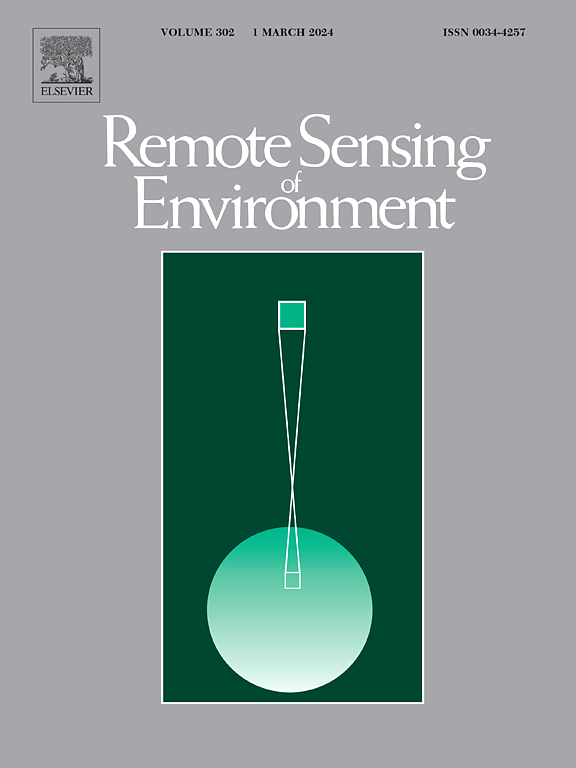过去40年加拿大北方-北极变绿过程中的量化正辐射强迫
IF 11.1
1区 地球科学
Q1 ENVIRONMENTAL SCIENCES
引用次数: 0
摘要
北部和北极地区的气候变暖推动了植被生长并改变了物种分布。在魁北克北部的北方-北极过渡地带(森林-冻土带过渡带),这可以从灌木(主要是矮桦树)取代地衣中看到。这些变化影响地表反照率,形成具有广泛影响的气候强迫。本研究对魁北克Umiujaq附近Tasiapik山谷的植被变化进行了测量,使用了(1)从地衣、矮桦树、柳树和云杉等62种植被组合中收集的高光谱数据(347-2400 nm)计算宽带反照率,以及(2)1984-2023年Landsat卫星遥感数据。结合这些数据,确定了40年期初和期末各像元植被类型的比例。对9.25 km2流域内6种主要植被类型的面积覆盖度进行了量化。变化最显著的是地衣被矮桦树取代,导致反照率从0.233降低到0.168,夏季短波强迫为11.17 W m−2。在山谷尺度上,考虑所有观测到的植被变化,夏季强迫的空间平均为2.16 W m−2。这些值低于挪威以前的研究,突出了由地衣替换引起的短波强迫的空间变异性。我们观察到产生最大正辐射强迫的植被变化也引起最强的绿化。这表明基于陆地卫星的绿化可以用作北极尺度上地表反照率变化的代理。这种独特的地面和卫星数据的结合,可以量化北极灌木化的直接一级效应。本文章由计算机程序翻译,如有差异,请以英文原文为准。
Quantified positive radiative forcing at a greening Canadian boreal-Arctic transition over the last four decades
Climate warming in northern and Arctic regions drives vegetation growth and shifts species distribution. In northern Quebec's Boreal-Arctic transition (forest-tundra ecotone), this is seen in the replacement of lichen by shrubs, primarily dwarf birch. These changes impact surface albedo, contributing to climate forcings with broad consequences. This study measures vegetation changes in Tasiapik valley near Umiujaq, Quebec, using a combination of (1) hyperspectral data (347–2400 nm) collected from 62 vegetation assemblages, including lichen, dwarf birch, willow, and spruce, to calculate broadband albedo, and (2) remote sensing data from Landsat satellites over 1984–2023. By combining these data, the proportion of vegetation type for each pixel was determined at the beginning and end of the 40-year period. The areal coverage of six main vegetation types was quantified over the 9.25 km2 valley. The most significant change was lichen replacement by dwarf birch with lichen understory, leading to an albedo reduction from 0.233 to 0.168 and a summer shortwave forcing of 11.17 W m−2. At the valley scale, the spatially-averaged summer forcing was 2.16 W m−2 when considering all observed vegetation changes. These values, lower than those in previous Norwegian studies, highlight the spatial variability of shortwave forcing due to lichen replacement. We observed that the vegetation change producing the greatest positive radiative forcing also caused the strongest greening. This suggests that Landsat-based greening may be used as a proxy for surface albedo change on an Arctic scale. This unique combination of ground and satellite data allows quantification of a direct, first-order effect of Arctic shrubification.
求助全文
通过发布文献求助,成功后即可免费获取论文全文。
去求助
来源期刊

Remote Sensing of Environment
环境科学-成像科学与照相技术
CiteScore
25.10
自引率
8.90%
发文量
455
审稿时长
53 days
期刊介绍:
Remote Sensing of Environment (RSE) serves the Earth observation community by disseminating results on the theory, science, applications, and technology that contribute to advancing the field of remote sensing. With a thoroughly interdisciplinary approach, RSE encompasses terrestrial, oceanic, and atmospheric sensing.
The journal emphasizes biophysical and quantitative approaches to remote sensing at local to global scales, covering a diverse range of applications and techniques.
RSE serves as a vital platform for the exchange of knowledge and advancements in the dynamic field of remote sensing.
 求助内容:
求助内容: 应助结果提醒方式:
应助结果提醒方式:


